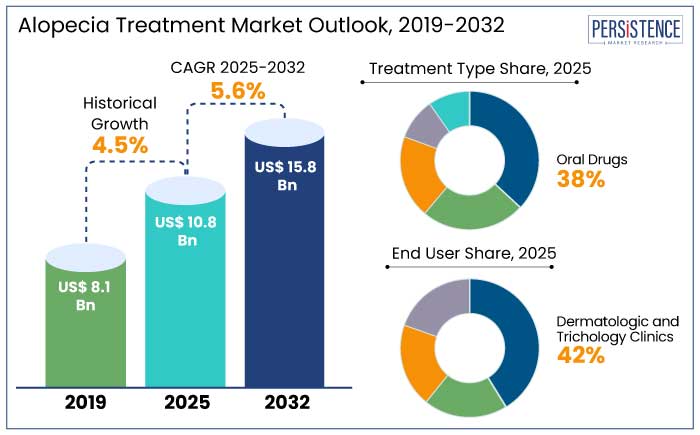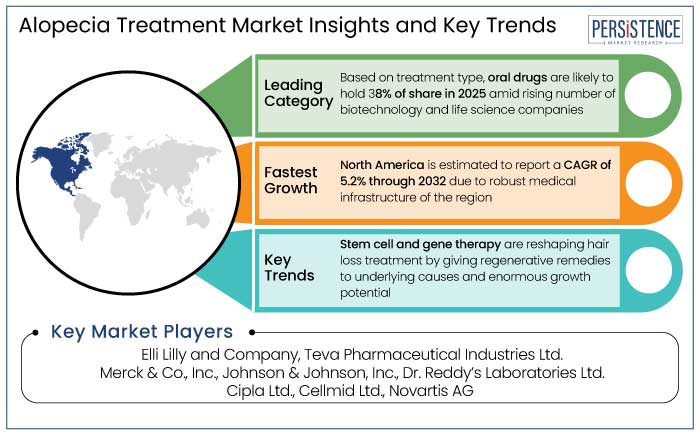Industry: Healthcare
Published Date: January-2025
Format: PPT*, PDF, EXCEL
Delivery Timelines: Contact Sales
Number of Pages: 196
Report ID: PMRREP9677
The global alopecia treatment market is projected to witness a CAGR of 5.6% during the forecast period from 2025 to 2032. It is anticipated to increase from US$ 10.8 Bn recorded in 2025 to a decent US$ 15.8 Bn by 2032.
Demand for alopecia treatment is driven by increasing awareness of treatment options and the high prevalence of hair loss. Over 95% of hair loss in men is caused by androgenetic alopecia, with nearly 40% of men experiencing some degree of hair loss by 35 years of age.
The need for treatment for androgenetic alopecia is expected to grow in revenue. Around 60% of the global population has hair thinning problems, with pattern hair loss being the most common form.
Healthcare expenditure is driving the industry due to rising consumer disposable income and a focus on aesthetic appearance in major countries. Organizations like the National Alopecia Areata Foundation and the American Hair Loss Association are promoting hair regrowth treatments, boosting healthcare expenditure, and driving market growth due to minimal side effects.

Key Highlights of the Market
|
Market Attributes |
Key Insights |
|
Alopecia Treatment Market Size (2025E) |
US$ 10.8 Bn |
|
Projected Market Value (2032F) |
US$ 15.8 Bn |
|
Global Market Growth Rate (CAGR 2025 to 2032) |
5.6% |
|
Historical Market Growth Rate (CAGR 2019 to 2023) |
4.5% |
North America is significant in the alopecia therapy industry, accounting for 37% of the total share in 2025. This is attributed to the high prevalence of the disease, government measures, and healthcare infrastructure improvements. North America is projected to report a CAGR of 5.2% from 2025 to 2032.
Government and non-profit organizations like the National Alopecia Areata Foundation and the Canadian Alopecia Areata Foundation are also contributing to the market. For example,
In 2025, the market for hair restoration and transfiguration in Europe is estimated to hold a share of 29%. The EU's second-largest producer of active biopharmaceutical drugs is seeing growth, with a forecast CAGR of 5.9% by 2032.
The need for hair restoration and transfiguration products has increased due to urban residents in Europe using 30% more hair care products than they did five years ago. In Germany, platelet-rich plasma treatment is likewise being utilized as a secure and efficient substitute for finasteride and minoxidil.
The growing number of cases of hair loss brought on by unhealthy eating habits, smoking, high levels of stress, and lifestyle choices is propelling the alopecia treatment industry in Europe. Europe's alopecia treatment market is thriving due to Germany's established healthcare system, public awareness, top pharmaceutical corporations, and advanced research.
The need for the discovery and production of biological products, as well as the growing number of biotechnology and life science firms, are predicted to drive demand for oral drugs to 38% of market share in 2025. Patients who are having fast hair loss are advised to take oral corticosteroids; these drugs are inexpensive but may have side effects. The most often recommended medication for androgenetic alopecia, or systemic hair loss, is finasteride.
Compared to topical or non-invasive remedies, oral formulations are more readily available and offer consistent dosages. Their usage is also being encouraged by innovative compounds with improved safety profiles and new advancements in oral formulations. Oral formulations are becoming more and more popular in the global alopecia therapy market due to patient awareness and dermatologists' evolving views.
Clinics that specialize in trichology and dermatology are becoming well-known because of their cutting-edge technology, individualized care, and rising patient confidence. Dermatologic and trichology clinics are anticipated to account for 42% of the market share in 2025.
The comfort and seclusion of these clinics are the main reasons for their appeal, especially in nations like China, South Korea, Japan, and Malaysia. Demand for hair loss treatments and service provider prices have benefited from the expansion of private clinics. Personalized alopecia therapy prediction systems were introduced by genetic testing firms in 2024, and these showed 70% accuracy in determining treatment response.
The alopecia treatment market is growing due to the rising prevalence of hair loss, psychological effects, and investments in regenerative medicine. Consumer knowledge and a decrease in stigma also increase investments in medical and cosmetic hair restoration.
Regenerative medicine has demonstrated 65% hair follicle regeneration potential, with leading pharmaceutical companies investing US$ 380 Mn in unique hair restoration technologies. The FDA accelerated approval processes for novel alopecia treatments, with Pfizer and Johnson & Johnson launching advanced topical and oral medications.
Mental health research has highlighted the psychological impacts of hair loss, leading to increased insurance coverage for comprehensive alopecia treatment programs. Personalized medicine and solutions have emerged, with genetic testing companies launching personalized alopecia treatment prediction platforms with 70% accuracy.
Unique laser and light therapy technologies have shown 55% improvement in hair follicle stimulation, and non-invasive treatment options gained market traction. Research shows that worldwide, people are 80% more interested in all-inclusive treatments for alopecia. These options include new non-invasive techniques, customized genetic approaches, help with psychological support, and stem cell regeneration technology.

The global alopecia treatment market recorded a decent CAGR of 4.5% in the historical period from 2019 to 2023. Based on the post-pandemic research, Alopecia affects more than 50 million U.S. citizens, including 30 million women and 50 million men.
Rising incidence of the ailment is driving the market for alopecia therapies. About 60% of people experience pattern hair loss, with gender-specific differences in severity. For instance,
Prevalence of Hair Loss Conditions Boosts Demand for Hair Care Solutions
Rising prevalence of hair loss conditions, such as androgenetic alopecia and alopecia areata, is driving growth in hair loss treatments. Increasing stress, hormonal imbalances, and aging have contributed to higher incidences of hair loss, with around 50 million men and 30 million women affected in the U.S. alone. For example,
Unique treatments like PRP therapy and stem cell-based solutions are gaining popularity due to the global demand for non-invasive, effective alopecia treatments.
Alopecia's Psychological Impact Drives Demand for Stigma-free Treatments
The psychological impact of alopecia is driving demand for novel treatment solutions, with research investments in regenerative medicine and hair restoration technologies increasing. For example,
Genetic research is revolutionizing treatment by using personalized medicine based on individual genetic makeup. Pharmacogenomics enables clinicians to identify hair loss mutations, enabling targeted treatments and creating drugs that align with a patient's genetic characteristics, promoting efficacy and minimizing side effects.
Limited Efficacy of Hair Loss Solutions Affects Industry
The global market for hair loss treatments is hindered by a lack of data on their therapeutic efficacy. Topical treatments like minoxidil are considered moderately effective, but not 100% effective against alopecia.
Laser treatments are often unaffordable, especially across countries in Asia Pacific and Middle East and Africa. High treatment costs, including novel treatments like PRP therapy and hair transplant surgeries, limit accessibility for many patients. For instance,
Insurance coverage disparities hinder treatment access, disproportionately affecting middle- and low-income populations. To address this, initiatives to make advanced therapies more affordable through subsidies, insurance inclusion, or cost-effective innovations are needed.
Innovation in Stem Cell and Gene Therapy Shows High Potential
Stem cell and gene therapy are reshaping hair loss treatment by giving regenerative remedies to underlying causes and enormous growth potential. Stem cell therapy, for example, has demonstrated the potential to stimulate hair follicle growth, with companies like Stemson Therapeutics developing unique cell-based regenerative treatments.
Such novel technologies provide long-term, minimally invasive solutions to meet the high health-conscious and aesthetics-driven consumer base.
Rising Investments in Research on Hair Treatment Present Growth Prospects
Demand for alopecia treatment solutions is anticipated to rise because of more investments in research and development with modern medications and formulations. For instance,
The market will also be driven by the foundation's calculated investments in immunogenetic research and a mouse model. The demand for hair fall treatments will increase even more thanks to strategic alliances with public and private institutions.
The alopecia treatment market is extremely competitive, with established and emerging players competing for positions in the global market. Because of their cost-effectiveness and broad patient acceptability, prominent firms are concentrating on oral formulations and creating innovative medicines.
Companies are collaborating strategically with industry leaders to remain ahead of the curve by utilizing their knowledge of formulation science, medication delivery technologies, and regulatory clearances. Pharmaceutical companies are spending money on the research and development of innovative oral formulations with enhanced bioavailability and precise distribution. To improve their alopecia treatment services, key rivals are extending business partnerships and combining through mergers and acquisitions.
?Recent Industry Developments
|
Attributes |
Details |
|
Forecast Period |
2025 to 2032 |
|
Historical Data Available for |
2019 to 2023 |
|
Market Analysis |
US$ Billion for Value |
|
Key Countries Covered |
|
|
Key Market Segments Covered |
|
|
Key Companies Profiled in the Report |
|
|
Report Coverage |
|
|
Customization and Pricing |
Available upon request |
By Treatment Type
By End User
By Region
To know more about delivery timeline for this report Contact Sales

The market size is set to reach US$ 15.8 Bn by 2032.
Researchers have developed a new treatment for alopecia areata, an autoimmune disorder causing hair loss, using a microneedle patch to deliver immune-regulating molecules.
In 2025, North America is set to attain a market share of 37%.
In 2025, the market is estimated to be valued at US$ 10.8 Bn.
Elli Lilly and Company, Teva Pharmaceutical Industries Ltd., Merck & Co., Inc., Johnson & Johnson, Inc., and Dr. Reddy’s Laboratories Ltd. are considered the leading players.